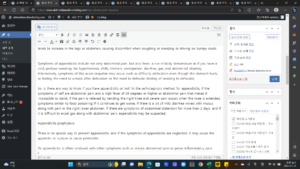Introducing the early symptoms of appendicitis. After reading this post, you will understand the early symptoms of appendicitis. If you need information on the early symptoms of appendicitis, please read to the end. Now, let me tell you about the early symptoms of appendicitis.
early symptoms of appendicitis
Lyme disease is easy to understand.
Appendicitis is an inflammation of the appendix, which is 6 to 9 cm long at the end of the appendix, and the official name of appendicitis is appendicitis. Appendicitis is a disease with a high incidence among people in their teens and 30s, and nearly 100,000 people visit hospitals with symptoms of appendicitis every year.
It is the cause of appendicitis.
The cause of appendicitis has not been clearly identified, but it is known that appendicitis located in the lower right abdomen is long or curved, and intestinal bacterial infection, chronic constipation, and allergies are pointed out as the causes of appendicitis.
In the case of teenagers, submucosal lymphatic vesicles proliferate and cause obstruction, and in adults, stool hardens and flows into the cecum, blocking the entrance.
This is an early symptom of appendicitis.
The initial symptoms of appendicitis are typically right lower abdominal pain, which starts with pain around the navel and gradually moves to the right lower abdomen, and symptoms such as diarrhea, a feeling of gas in the stomach, loss of appetite, nausea, and vomiting appear. Regardless of gender, the location of the appendix causes symptoms of pulling the side and ribs to the right or pain in the right lower abdomen.
However, in children and pregnant women, pain may occur in other parts of the abdomen, and pain from appendicitis tends to increase in the legs or abdomen, causing discomfort when coughing or sneezing or driving on bumpy roads.
Symptoms of appendicitis include not only abdominal pain, but also fever, a rise in body temperature as if you have a cold, profuse sweating like hyperhidrosis, chills, tremors, constipation, diarrhea, gas, and abdominal bloating. Alternatively, symptoms of this acute sequelae may occur, such as difficulty defecation even though the stomach hurts, or feeling the need to urinate after defecation or the need to defecate (feeling of needing to defecate).
So, is there any way to know if you have appendicitis or not? In the self-diagnosis method for appendicitis, if the symptoms of self are abdominal pain and a high fever of 39 degrees or higher or abdominal pain that makes it impossible to stand, if the pain is relieved by bending the right knee and severe pain occurs when the knee is extended, symptoms similar to food poisoning If it continues to get worse, if there is a lot of mild diarrhea mixed with mucus along with pain in the right lower abdomen, if there are symptoms of abdominal distension for more than 2 days, and if it is difficult to expel gas along with abdominal pain, appendicitis may be suspected.
Appendicitis prophylaxis.
There is no special way to prevent appendicitis, and if the symptoms of appendicitis are neglected, it may cause the appendix to rupture or cause peritonitis.
Or appendicitis is often confused with other symptoms such as simple abdominal pain or pelvic inflammatory pain because the pain on one side of the stomach is severe.

A useful post to look at
Post Traumatic Stress Disorder (PTSD) diagnosis criteria completed for easy viewing
Ankylosing spondylitis symptoms are easily summarized.
We have organized the symptoms of precocious puberty so that it is easy to see.
I shared the early symptoms of appendicitis. Hope this helps. If you have additional questions, please refer to the above articles.